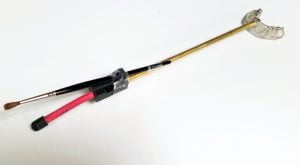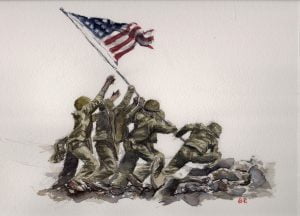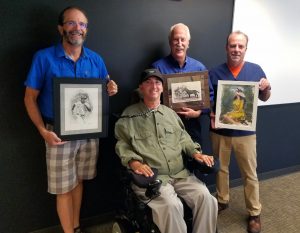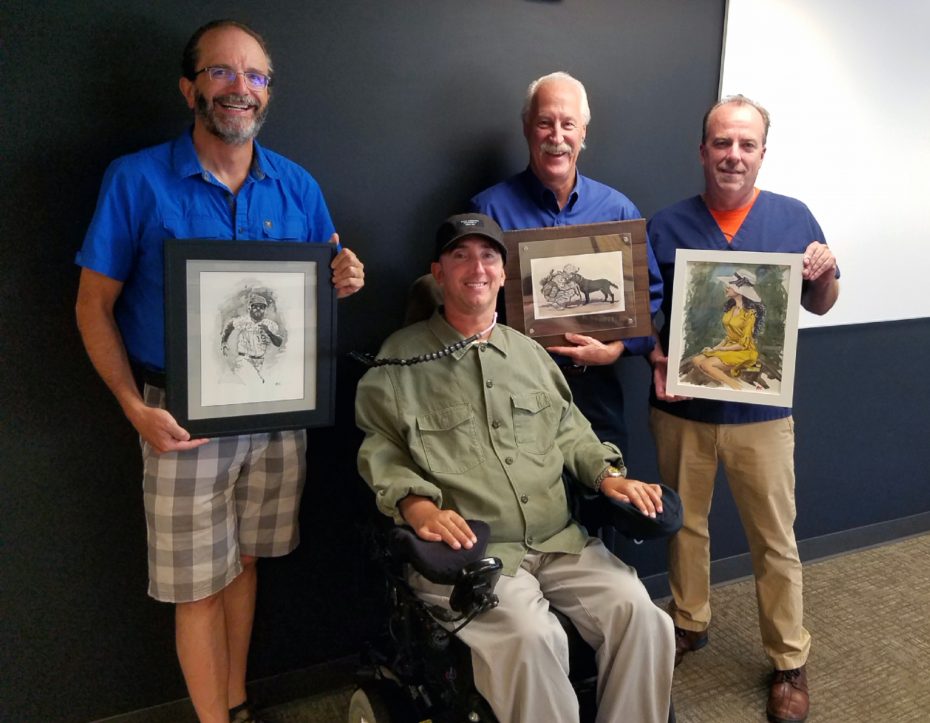By Molly Pereira, CDA Associate Executive Director
From the Fall 2019 Journal of the Colorado Dental Association
Each year, Craig Hospital hosts a gala to raise awareness and funding for the hospital’s programs and research, which is dedicated to specialty rehab for people with spinal cord injuries and traumatic brain injuries (TBI). During the evening’s auction, an incredible watercolor painting of Iwo Jima was up for bid. The painting generated one bid after another, eventually reaching $835. Sold! The new owner admired the painting, but the true awe was the artist behind brush.

Brett Colonell has performed a live art demonstration at the Craig Hospital PUSH Gala for the past two years. His paintings are then auctioned off during the event to benefit the hospital’s programs and research. This watercolor, Piano Player, was sold to the highest bidder for $715.
Brett Colonell is an artist, a dual degreed mechanical engineer, and a quadriplegic. He grew up in Arvada, CO and spent every minute he could running, fishing, mountain biking, motor biking, camping and playing outdoors. He was a good student, well liked and followed a traditional plan of graduating from high school and going to college to pursue a degree. In the summer of 1997, however, after his sophomore year at the University of Colorado at Boulder, his plan became less traditional.
It was just another day having fun, practicing wheelies on his motor bike with his friends in a grassy field, when his front tire hit a mound sending Brett over his handlebars and landing him directly on his head.
“When you come down, it’s an instinct to get up,” Brett said. “It felt like I got the wind knocked out of me. I remember my friend touched my leg, but I couldn’t feel it. Luckily my friend had a cell phone, which wasn’t common in 1997, and called 911.”
A flight for life helicopter rushed him to the hospital. Among several injuries, his right humerus snapped in half and he suffered a complete spinal cord injury at the level of C-4/C-5.
“The thought of being paralyzed never crosses your mind,” Brett recalls. “It wasn’t until a day or two after the incident that the surgeon working with me told me that I shattered my fifth vertebrae and some of the fourth. He said, ‘You’re permanently paralyzed.’”

Brett Colonell’s mouth stick has a metal framework within a clear acrylic body. The actual stick is a standard piece of brass tubing, connected to the mouthpiece framework. Various tools can be connected to the tip of the stick at a desired angle.
Brett spent June through October that year rehabilitating at Craig Hospital, learning how to function completely hands-free from a wheelchair. He recalls being most upset over the fact that he couldn’t go back to CU for the fall semester. After months of hard work, healing and occupational therapy, he learned how to function using a standard “stock” mouth stick.
A standard mouth stick incorporates a 2-3 mm thick wafer that is held in place with forceful biting. That thickness can lead to an unnatural bite position and muscle fatigue, in addition to jaw pain and TMD.
Brett used the mouth stick to flip book pages and dial phones. He returned to the mechanical engineering program in the spring of 1998 with special permission from the dean to take a restricted class load. He had to not only learn engineering equations but how to write them using adaptive equipment and voice activation programs, which in the late ‘90s lacked precision, efficiency and privacy.
“It was really time consuming and took patience,” he said. “Things that would take a normal person an hour, would take me three hours.”
After years of dedication, he graduated in the winter of 2001. Due to the economic downturn at the time, he found it difficult to get a job and decided to return to school to pursue an MBA, which he earned from CU Denver in 2007. In 2008, another financial crisis hit and again, Brett struggled to find a job in his field. He passed the time by using his mouth stick to draw on his iPad and sketch on paper. He also met with a career counselor who challenged him to find a career that supported his passion.
“I always liked drawing and doodling but never thought about being an artist,” Brett said. “Being able to draw was always part of engineering. It wasn’t until after my injury that I really started pursuing art. I needed a creative outlet. I couldn’t not do anything. That would be my biggest fear.”

Iwo Jima watercolor by Brett Colonell.
For years, he asked if there were any advancements in mouth sticks, but the industry wasn’t evolving.
“I was using a stock mouth stick to draw on my iPad,” he said. “I would spend a whole afternoon melting athletic mouthguards to make the stock mouth sticks more comfortable and to get the bite just right. It worked pretty well but wouldn’t last more than a year.”
One day, his occupational therapist asked if he had heard of a custom-made version of a mouth stick. Soon after, he was introduced to Dr. Mike Diorio, a general dentist in Englewood, CO and now a part-time staff member of Craig Hospital.
Dr. Diorio had been working for a few years to develop a mouth stick that was thinner and would allow the teeth to come closer to fully closing.
“It needed to depend on less force to hold and use, and had to be lightweight, but strong,” recalled Dr. Diorio. “The mouth stick had to rest passively over the mandibular arch, like a lower retainer, sports guard or bleach tray. It also needed to be able to hold an actual stick for function. A mouth stick should allow the jaw muscles to relax and still remain in place.”
Dr. Diorio worked on several designs for custom mouth sticks with Steve Kelly and Rick Peebles, of Peebles Prosthetics, Inc.
“Our early designs were not strong enough to handle the forces created by the leverage on the mouthpiece,” Rick recalled. “The acrylic would break and so would the metal neck supporting the stick, creating needed repairs. The design was modified to include a full arch chrome substructure to support the acrylic as well as create occlusal bite stops for the opposing dentition. The stick support, a part of the substructure, was moved to come off the mandibular incisal edge, which allowed it to be strengthened.”
The team’s work to refine the mouth stick is ongoing—they’ve made dozens over the past 15 years, working with Craig Hospital patients. A patient’s needs and physical limitations are a substantial consideration in addition to the angle of the stick itself—how far the stick must angle down from the occlusal plane. The angle is generally determined by the occupational therapist but is typically 10-15 degrees. The mouth stick must be secure and stable, yet easy for the patient to place and remove his/her own.
“We have to make sure the occlusion is correct with an even distribution of bite forces,” Rick said. “We also have to be sure that the removal and insertion process does not cause tissue irritation. Lastly, we need to consider compromised dentition.”
The patient must have enough lower teeth to support the device. The teeth must be solid and stable and the patient must be able to open wide enough to accommodate an impression.
Brett’s teeth were unharmed in his accident. He is able to shrug his shoulders, turn his neck and use all his facial muscles.
“Once I got the custom mouth stick, I really got into painting,” Brett recalls. “That’s as close to doing something by hand as I’ll ever get.”
Brett admits that adjusting to the custom mouth stick took time. After using a soft athletic guard where pressure is directed to the molars, it was very different to get used to a rigid guard that passively slides over his lower teeth.
“A regular mouth stick causes my mouth muscles to cramp after about an hour,” he said. “The custom mouth stick never causes strain. It’s almost passively floating—I don’t have to bite down on it. Angle is very important too. I need my mouth stick angled down about 15 degrees.”
Brett uses a variety of mouth sticks and typically wears one for four hours each day. He uses a regular mouth stick with a pencil taped to it for a quick sketch but uses his custom mouth stick to create detailed pieces of art because it allows him to be steadier with his brush strokes.

Dr. Mike Diorio (left), Brett Colonell, Rick Peebles and Steve Kelly hold just a few of Brett’s art pieces, currently on display at Peebles Prosthetics in Lakewood.
The challenge he faces now is not being able to switch out the tools on a mouth stick himself.
“I pre-plan things and decide what I want to create (and what tools I need to use) ahead of time because I need assistance to switch between different mouth sticks.”
Rick and Steve recognize this challenge and continue to work with Dr. Diorio to invent a solution that allows the patient to be able to independently change the tool that attaches to the mouth stick (i.e. pencil, pen, paint brushes, stylus, etc.), as well as offering a mouth stick that would allow for an adjustable angle.
“I would love to have the ability to 3-D print at least the mouth portion of the mouth stick,” said Dr. Diorio. “It would be less expensive, and the material would still be strong and thin.” The bare bones cost to create a mouth stick now is approximately $400.
“We need to find ways to have some interchangeability, creating more patient independence, keeping it cost effective and increasing mouth stick accessibility,” Rick said.
When asked what his life would be like without a mouth stick, Brett paused to think and finally said, “It’s hard to answer. I definitely couldn’t do what I would enjoy. This has opened up a whole new world for me. I was invited to join a painting group that meets every Wednesday night; it was intimidating to go that first night. It is a really fun group to be around; they’re very supportive and interested in the process I do.”
What motivates Brett? He is grateful for his health and thankful that he can be productive. He lives for the present, not necessarily the big picture. He sets goals and then puts everything into meeting that goal.
“I concentrate on what I can control and focus on it. It helps me keep a positive outlook on life. I can plan for the future, but you never know what the future will be. People talk about art as a talent or gift, but for me it’s the attitude of problem solving, practicing and not quitting.”
Art is what Brett pursues nearly full-time. He has created over 100 pieces, either digitally or traditionally. His favorite medium is watercolor, however, don’t be surprised to see a little of his ink work this month supporting “Inktober.” He also displays his art in the Peebles Prosthetics gallery, which also displays art from the Lakewood Arts Council.
“When we first started working with Brett, we had no idea of his talents,” Rick said. “We rarely have the opportunity to meet the patient, let alone continue to stay in touch with them and watch their progress. It’s this kind of success story that bolsters the spirit to continue to find solutions to challenging situations.”
“Dentistry has the ability to be life changing,” Dr. Diorio said. “What we do is an off-the-beaten-path service that transforms life for a small select population.”
To see Brett’s work, visit youtu.be/ySDWyKD7Ro8, instagram.com/brettcolonell or facebook.com/brett.colonell.


